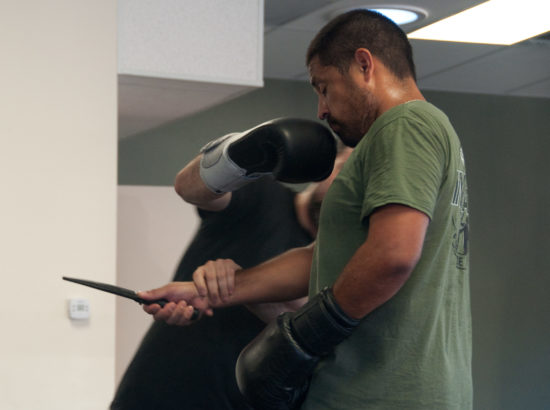
Full Contact Krav Maga training at Impact
Krav Maga training encompasses three main elements: technical abilities, physical preparation and mental conditioning. Although each element is independently important for the student’s development, we believe that it is the correct ratio of all three elements that really elevates the student’s progression as a fighter.
Take a straight punch as an example. Technical training involves understanding and learning the mechanics of the punch. Then, understanding the targets, and ultimately the application of this tool from various conventional and unconventional positions, i.e. ready vs. passive stances, sitting, laying, standing, etc. Physical training involves making the punch stronger by making the person fitter and more explosive. Similarly, the tool itself is strengthened by conditioning the knuckles against different punching surfaces. Of course, making the punch stronger by simply making the puncher stronger is not sufficient, nor is just simply focusing on the mechanics of the punch alone. Constantly refining the technical nuances, while increasing stamina and strength is what makes the punch more effective. Let’s not forget mental conditioning. Can you punch while being tired, or if you are on the ground surrounded by multiple attackers and you need to punch your way out of trouble? These are just some examples that are in essence a way to test and condition your mind to deal with fear and stress, build aggression and determination and perform as needed. Of course, conditioning your mind alone is not sufficient, in fact it goes hand in hand with fitness and technical abilities. The more stamina and strength you have the easier it gets to perform under severe stress. Similarly, the more confidence you have in your techniques, the more you have trained to punch from various positions the better you will deal with stressful events.
All of our classes are designed to complement each other and develop a correct blend of these three essential elements. Full Contact classes are no exception. After completion of their Practitioner 1 rank students are invited to attend these classes that further advance their self-defense and fighting abilities. So what can you expect from these classes?
First of all you are further refining your physical and mental conditioning. You are now working with some level of contact, so the stakes are higher, the stress level is elevated and fatigue is a bigger factor. Some classes will focus on physical and mental aspects of training, where you will have to fight multiple opponents, fight from positions of disadvantage, fight a barrage of endless attacks, absorb strikes, develop stamina, strength, will and determination to get past any obstacle. Of course physical and mental training go hand in hand with technical development. So attention is paid to the technical elements surrounding techniques and tactics needed to deal with armed and unarmed opponents, multiple opponents, defending against single and combination of strikes and ground fighting, all while dealing with hitting and being hit. Basically you are now taking the skills acquired in regular classes and are refining them with an element of contact training with a non-compliant attacker to better simulate the reality in the street. Think of the example of the straight punch we discussed earlier. Simply put, in full contact training, you are now seeing how well you can punch while someone is punching you back.
A couple of differences between regular and full contact classes. One is the introduction of gloves. Gloves are used in full contact to protect your partner from taking a punch with bare knuckles. And although students are already used to gloves from our striking classes, learning how to defend strikes with gloves is mainly taught in full contact training. On the street neither you nor your attacker(s) will be wearing gloves, so it is more important to learn how to perform defenses bare handed. But for the sake of safety, and to add the benefit of contact training, students are taught to adjust these defenses while wearing gloves.
The second major difference is the introduction of sparring. Sparring is light, controlled, strategic fighting between two or more people that improves movement, positioning, striking, defenses, distance management, timing, decision making and other components of fighting, including physical fitness and mental conditioning. However, sparring is not a true representation of a violent attack where the attacker is intent on causing severe injury to the victim. If you ever see two boxers get into a physical altercation outside the ring, neither one of them is using boxing to hurt the other. Yes, both are throwing very skilled punches, but neither one of them is bobbing and weaving, there is no strategy and no feeling out time between the two fighters. Simply put both are trying to land the most devastating strike on the other, which is usually done with a single or a two punch combination. So when training fighting in full contact training, sparring alone is not sufficient. In fact, it is again a blend of drills that we have developed at Impact Krav Maga that ensures that Full Contact training has the proper ratio of technical, physical and mental attributes needed to further advance the students fighting and self-defense skills. These classes in combination with our Core Krav Maga, Basics Krav Maga, and Strike Lab classes produces some of the most skilled practitioners of Krav Maga in the world, and more importantly gives these practitioners the necessary skills needed to protect themselves and their loved ones.
